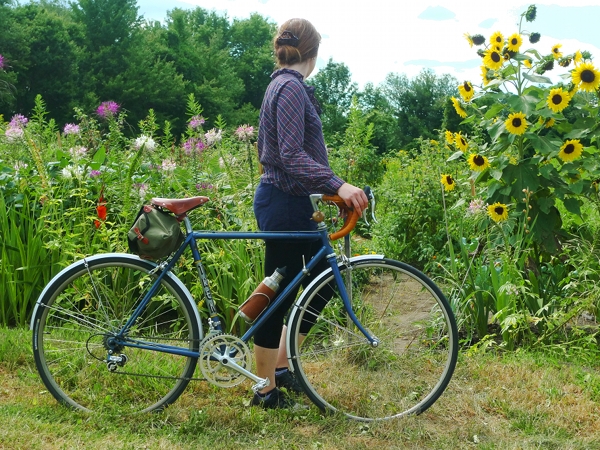
As some have already noticed, I recently acquired one more bicycle that I have not yet written about. It is a vintage
Trek roadbike - fast and aggressive, with super-responsive handling. Don't ask how I got the bike; sometimes these things just find you. It was in exactly my size, and came along at a time when I had begun to experiment with more aggressive road cycling. I wanted to try a "real" roadbike without spending more money, and here was my chance.
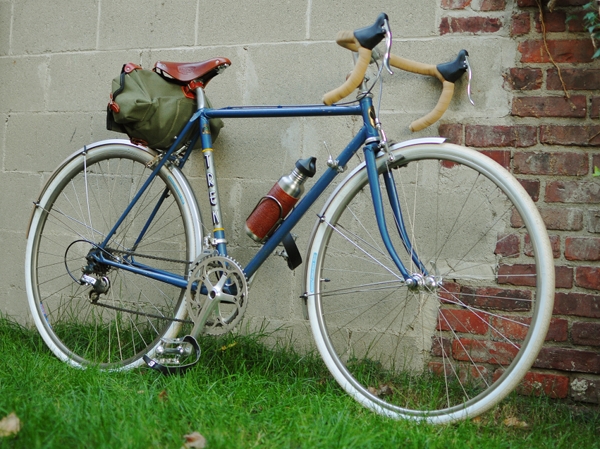
So please allow me to introduce Seymour Blueskies. He is a Trek 610, built in 1982. The lugged steel frame is made with
Reynolds 531 tubing, and cro-moly fork and stays. The frame is 52cm, with 700C wheels.It is an interesting blue-gray colour that
Trek called "gunmetal"in its catalogues.

The 610 was a higher-end model, and the previous owner built it up with nice components - though over the years they had become somewhat of a medley.

The wheels were handbuilt using
Rigida racing rims with a gunmetal finish, a
Campagnolo rear hub, a
Suntour XC 9000 front hub, and double butted spokes. The drivetrain is
Suntour Sprint 9000, with
Suntour downtube shifters. The stem is vintage
Nitto and the handlebars are
ITM. The bicycle also came with a
Brooks Finesse Titanium(!) women's saddle.
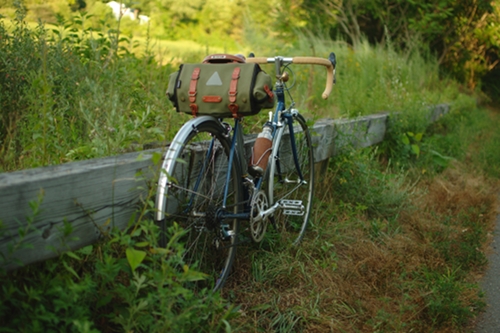
I have kept all of the components as they were, except for the brakes and brake levers, which we replaced with new
Tektros.We also added cork bar tape, installed SKS fenders and a bottle cage, replaced the original clipless pedals with
MKS Touring pedals (with
Powergrips), and attached my
Zimbale bag and a
Crane bell from another bike.
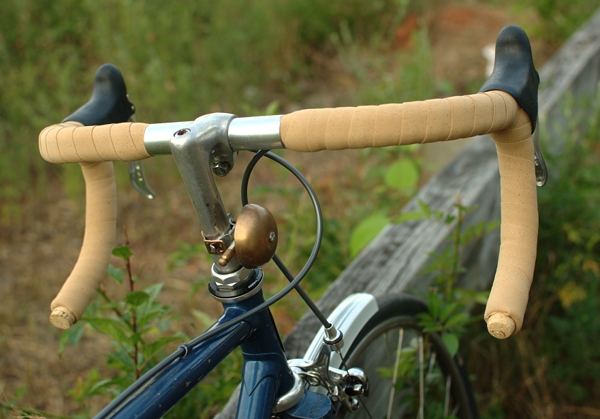
I prefer cloth tape on handlebars, but these bars have a weird, squared-off shape to them with a carved-out channel for cable routing. This can all be felt though cloth tape, making the bars uncomfortable to hold without a layer of cork. They are also a bit too narrow for me, and if the
Trek ends up being a keeper I would like to replace them with something like
Nitto Noodles, or a vintage equivalent.
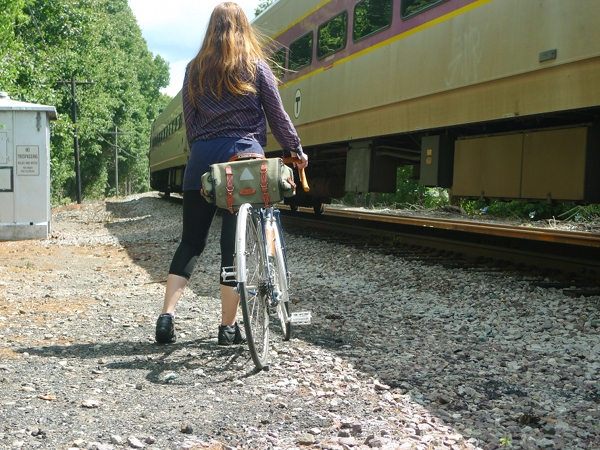
The reasoning behind the
SKS fenders was initially budget-driven, but I am very happy with this choice. They are quieter and less fussy than
Honjos; I hardly even notice them. The Co-Habitant hates
SKS fenders, because he thinks they are "ugly". I do not find them "ugly"; just more sporty than Honjos - which was exactly the look I was going for here. Incidentally - even with the fenders, saddlebag and waterbottle, the
Trek is the lightest bicycle I own.

After a few weeks of ownership, I have also justreplaced the original
Michelin 25mm tires with 28mm
Panaracer Paselas in white. The
Michelinsthat came with it are supposed to be fantastic, but they felt hard as rocks and made for a very harsh ride. The
Paselas, on the other hand, feel as if I am riding on a cloud. 28mm tires are probably the widest this bicycle will fit with fenders, and that is fine with me.
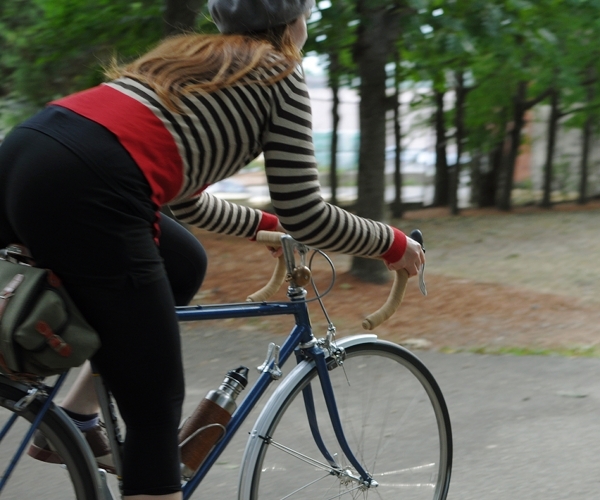
Now, for the ride quality... The vintage
Trek handles
very differently from the
Rivendell Sam Hillborne. The best way I can describe this bike's behaviour, is that it wants to go fast and does not like to go slow. At slow speeds the
Trek feels unstable and difficult to maneuver, especially when cornering. It took me a few rides to learn how to handle this without panicking, but eventually I got used to it. By the same token, it becomes amazingly stable and precise at fast speeds: Once I exceed 16mph, it seems to magically "relax" and almost floats above the asphalt. Accelerating is easy - almost too easy! One turn of the pedals, two turns - and before I know it, I am
flying. This is great fun now that I am more or less comfortable on a roadbike, but even a couple of months ago I would not have been able to handle this kind of cycling. When riding the
Hillborne, I feel that I am exploring - I can go fast, or I can go slow. Riding the Trek, I feel that I preparing for a race - going slow is not really in the cards.

All other factors remaining equivalent (road and traffic conditions, my energy levels, etc.), the
Trek is a faster ride than the
Rivendell. I cannot tell how much faster exactly, because conditions are never identical on any two rides - but when the Co-Habitant accompanied me, he said the difference in my speed on the two bikes was noticeable. One explanation for this could be that the
Trek's handlebars are set lower, but it could also just be that the bike is designed to be a bit racier. On the flip side of the speed advantage, the
Trek is not as comfortable as the
Rivendell(which is insanely comfortable) and encourages over-exertion - leaving me feeling far more exhausted after a ride. One curious thing about how I feel on the
Trek, is that my hands always hurt at the beginning of a ride - but stop hurting as the ride progresses and I pick up speed. This is surprising, because when something hurts at the start of a ride, it typically only gets worse the longer I cycle - so each time I get on the bike I have to suspend disbelief and remind myself that my hands
will stop hurting in a few minutes. And thankfully, they always do. I also find it challenging to hold the drop portions of the bars on the
Trek (something I have already mastered on the
Rivendell) without losing some control of the bike or at least weaving a bit. I am sure this will feel comfortable eventually, but I am not there yet. Just yesterday, I was finally able to use the downtube shifters for the first time - after having tearfully declared that they were "impossible" time after time on previous rides. Everything takes practice.
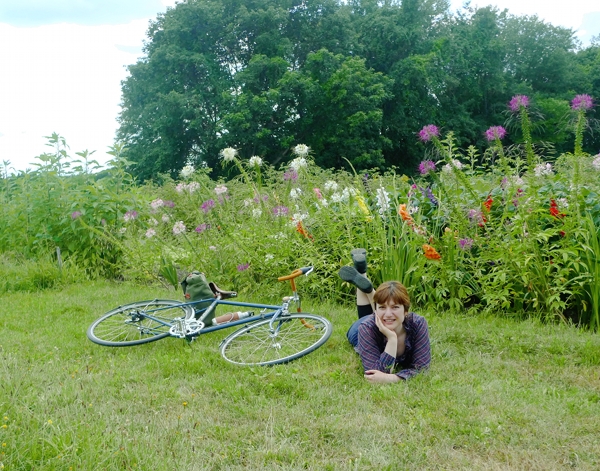
When I first got the
Trek, I was not at all sure that I would be keeping it. We modified it just enough to make me comfortable, and it would be easy to resell this bike at no loss. I wanted to experience a "real" roadbike without the coddling qualities of the
Rivendell, and now I have. So what next? Well, I don't know yet, but I don't really want to let it go. It has been bewildering to discover that I kind of, sort of might actually be
good at road cycling, and I would like to see this discovery through. Depending on how much time I have in a day for a ride, I take either the
Rivendell (for long rides), the
Trek (for medium, but fast paced rides), or the
fixed gear Moser (for shorter, intense rides) - and together they are helping me understand my potential.









 I often detour from the way and have alook around this lake, it has to be said I have never seen it frozen.
I often detour from the way and have alook around this lake, it has to be said I have never seen it frozen.






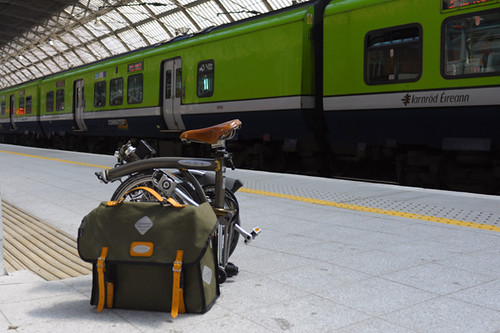

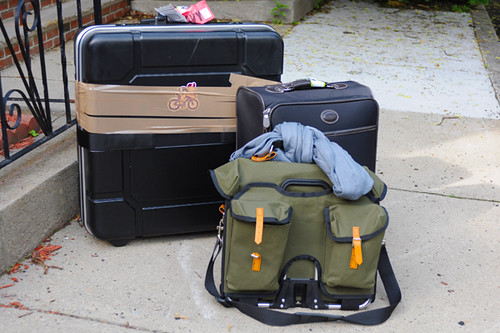
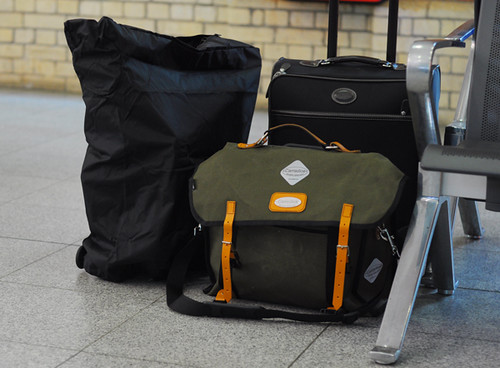
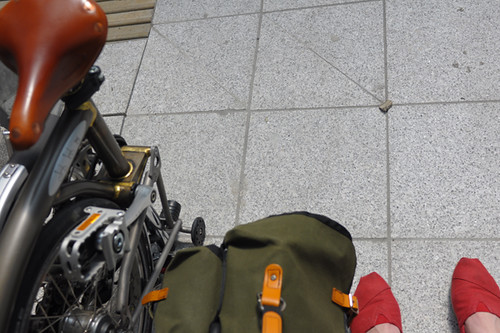
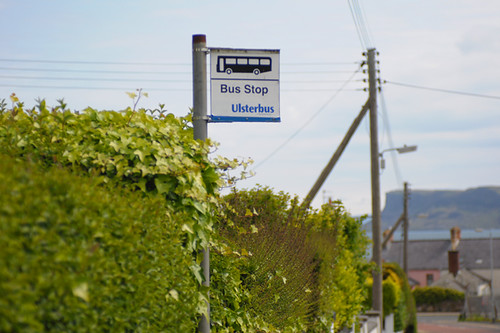


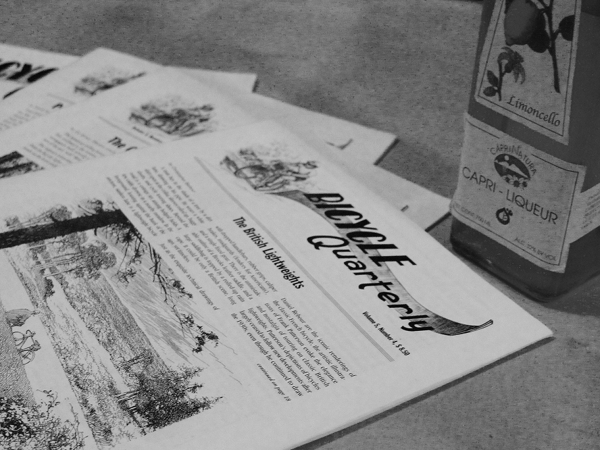 I've been gifted a stack of olderBicycle Quarterlyissues (thanks, A!) and a few of them are redundant with the ones I already have. So, if anybody wants them, I have the following three to give away:
I've been gifted a stack of olderBicycle Quarterlyissues (thanks, A!) and a few of them are redundant with the ones I already have. So, if anybody wants them, I have the following three to give away: Since the start of this blog, I've received more requests to review the Breezer Uptown than any other city bike on the market. I have not done so earlier for two reasons. First, availability: Until now, I had not seen the Breezer for sale in any local bike shop. After a break of several years Harris Cyclery now carries them again, which is how I came across this one. But additionally, I was reluctant to review a bike that I was unenthusiastic about: theBreezerhas never appealed to me, and I have no interest in it other than general industry curiosity. However, I would have said the same about Seven Cycles a year ago, and trying one of those (in response to readers' requests as well) had a profound effect on me as a cyclist. I also unexpectedly liked the Urbana, which I tried for no reason other than the manufacturer's urging. In short, you never know and it's good to keep an open mind. That is how I approached my test ride of the Breezer Uptown.
Since the start of this blog, I've received more requests to review the Breezer Uptown than any other city bike on the market. I have not done so earlier for two reasons. First, availability: Until now, I had not seen the Breezer for sale in any local bike shop. After a break of several years Harris Cyclery now carries them again, which is how I came across this one. But additionally, I was reluctant to review a bike that I was unenthusiastic about: theBreezerhas never appealed to me, and I have no interest in it other than general industry curiosity. However, I would have said the same about Seven Cycles a year ago, and trying one of those (in response to readers' requests as well) had a profound effect on me as a cyclist. I also unexpectedly liked the Urbana, which I tried for no reason other than the manufacturer's urging. In short, you never know and it's good to keep an open mind. That is how I approached my test ride of the Breezer Uptown.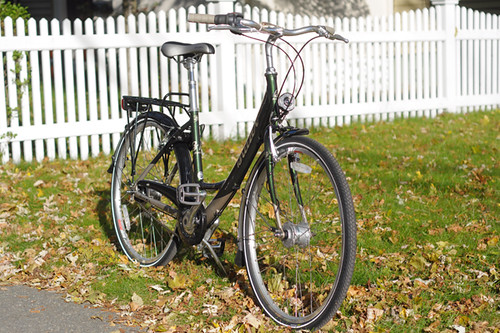 The Uptown is Breezer's fully equipped commuter model, available in 3-speed and 8-speed variants. The bike includes fenders, a chainguard, a rear rack, a kickstand, an integrated rear wheel lock, and front and rear dynamo lighting.
The Uptown is Breezer's fully equipped commuter model, available in 3-speed and 8-speed variants. The bike includes fenders, a chainguard, a rear rack, a kickstand, an integrated rear wheel lock, and front and rear dynamo lighting.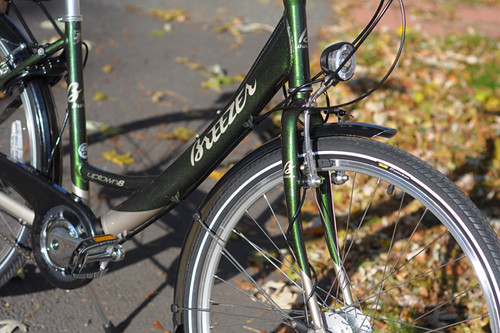 The welded aluminum U-frame has "unitube" construction.Steel unicrown fork. The 26" wheels are fitted with 1.5" wide tires.I tried the 17" sized frame. There are other sizes and also a diamond frame version.Please seeherefor full specs.
The welded aluminum U-frame has "unitube" construction.Steel unicrown fork. The 26" wheels are fitted with 1.5" wide tires.I tried the 17" sized frame. There are other sizes and also a diamond frame version.Please seeherefor full specs. The colour is a deep, sparkly forest green, with contrasting silver panels on the chainstays, near the bottom bracket,and on the fork. The two-tone paint job gives the bike a sporty look that strikes me as being at odds with its purpose as a commuter. But the dominant green colour is pleasant.
The colour is a deep, sparkly forest green, with contrasting silver panels on the chainstays, near the bottom bracket,and on the fork. The two-tone paint job gives the bike a sporty look that strikes me as being at odds with its purpose as a commuter. But the dominant green colour is pleasant.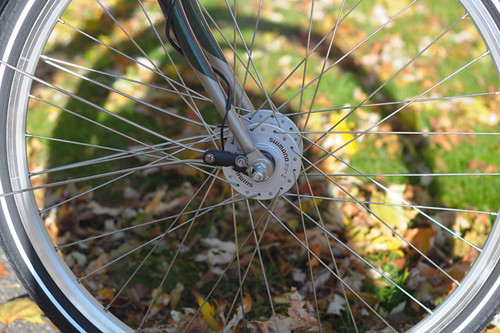 As far as functionality, it must be said that this bike is excellently equipped for commuting. Front and rear dynamo lighting seems to be of good quality and is internally routed, exiting through the rear fender for the tail light.
As far as functionality, it must be said that this bike is excellently equipped for commuting. Front and rear dynamo lighting seems to be of good quality and is internally routed, exiting through the rear fender for the tail light.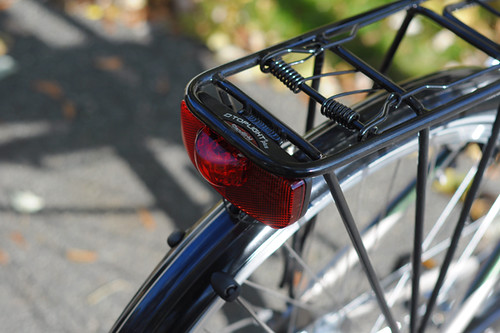 The rear rack's tubing will accommodate a variety of pannier systems.
The rear rack's tubing will accommodate a variety of pannier systems.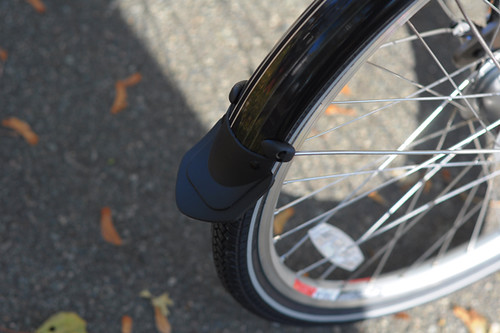 The tires are wide. The fenders provide full coverage and include small plastic mudflaps.
The tires are wide. The fenders provide full coverage and include small plastic mudflaps.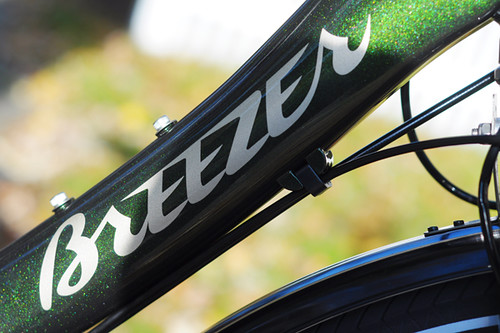 There are braze-ons for the shifter and brake cables, so that nothing is hanging loose, and there are waterbottle bosses.
There are braze-ons for the shifter and brake cables, so that nothing is hanging loose, and there are waterbottle bosses.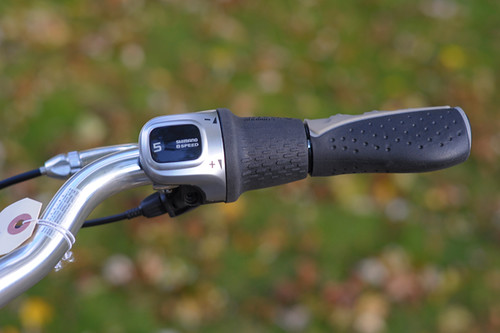 The wide range Shimano8-speed hub could be attractive for hilly areas. The shape of the handlebars provides a sufficient gripping area despite the twist shifter.
The wide range Shimano8-speed hub could be attractive for hilly areas. The shape of the handlebars provides a sufficient gripping area despite the twist shifter.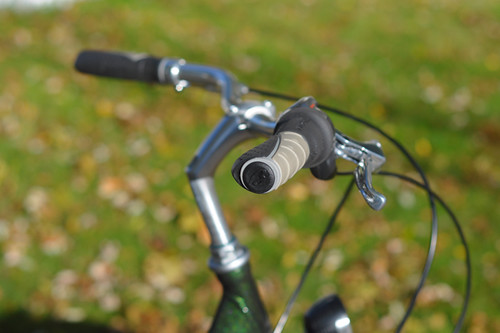 The handlebars are mildly swept back. The brake levers are comfortably placed, and the front and rear v-brakes provide strong stopping power.
The handlebars are mildly swept back. The brake levers are comfortably placed, and the front and rear v-brakes provide strong stopping power. All of these features, for a retail price of $980 (or $720 for the 3-speed model), make the Breezer Uptown look undeniably good "on paper." This is the kind of commuter bike you are likely to find in a mainstream European bike shop today - modern, affordable, fairly lightweight, designed to be ridden in everyday clothing, and fully equipped - and it's great to see the same available in the US.
All of these features, for a retail price of $980 (or $720 for the 3-speed model), make the Breezer Uptown look undeniably good "on paper." This is the kind of commuter bike you are likely to find in a mainstream European bike shop today - modern, affordable, fairly lightweight, designed to be ridden in everyday clothing, and fully equipped - and it's great to see the same available in the US.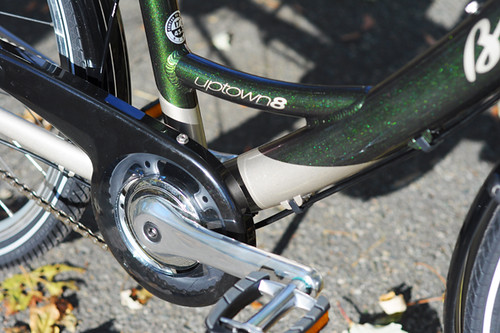 Having said that, I did not like this bike on a number of levels. From an aesthetic and emotional standpoint, I found the Breezer to be "unlovable." The huge welds, the hollow feel of the aluminum tubing, the athletically-inspired colour scheme - it all feels so generic and impersonal. I like a bicycle with some warmth to it, with some evidence of a human touch, and I just don't feel any sense of this from the Breezer. It's not just about lugged vs welded and steel vs aluminum, but about the very essence of how the bike feels to look at, to touch and to ride. This is truly the vacuum cleaner of bicycles - and while for some that's a good thing, for me it's uninspiring.
Having said that, I did not like this bike on a number of levels. From an aesthetic and emotional standpoint, I found the Breezer to be "unlovable." The huge welds, the hollow feel of the aluminum tubing, the athletically-inspired colour scheme - it all feels so generic and impersonal. I like a bicycle with some warmth to it, with some evidence of a human touch, and I just don't feel any sense of this from the Breezer. It's not just about lugged vs welded and steel vs aluminum, but about the very essence of how the bike feels to look at, to touch and to ride. This is truly the vacuum cleaner of bicycles - and while for some that's a good thing, for me it's uninspiring.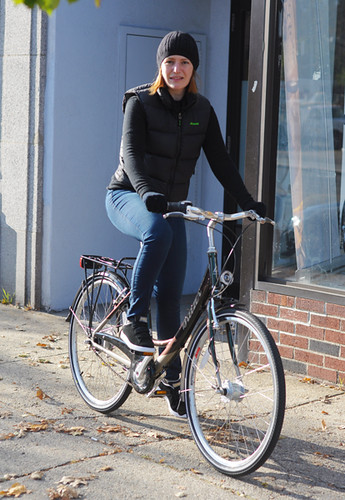 But more importantly - and more disappointingly - the Breezer's ride quality did not work for me. I rode it for about 3 miles and already felt the sort of strain in my knees that I've experienced on bikes with the infamous "comfort" geometry. This could also be because I would consistently end up in a gear that was too high: I found that being in too high of a gear was the only way I could make the bicycle go at the speed I wanted. In a gear where my cadence felt appropriate, the bike would not move fast enough for my liking.
But more importantly - and more disappointingly - the Breezer's ride quality did not work for me. I rode it for about 3 miles and already felt the sort of strain in my knees that I've experienced on bikes with the infamous "comfort" geometry. This could also be because I would consistently end up in a gear that was too high: I found that being in too high of a gear was the only way I could make the bicycle go at the speed I wanted. In a gear where my cadence felt appropriate, the bike would not move fast enough for my liking. 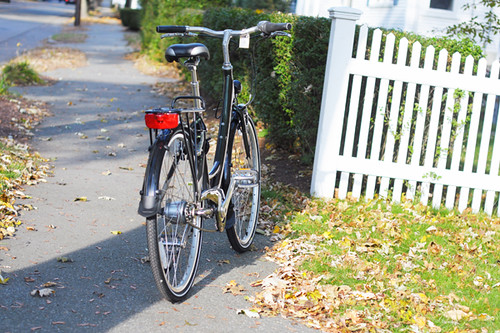 On a positive note, I thought the BreezerUptown was solidly put together and truly functional, unlike other bikes that only play at being fully-equipped commuters. It was also stable and well-balanced, and there was no toe overlap on the 17" frame. This bike should be easy to handle for a novice transportation cyclist.
On a positive note, I thought the BreezerUptown was solidly put together and truly functional, unlike other bikes that only play at being fully-equipped commuters. It was also stable and well-balanced, and there was no toe overlap on the 17" frame. This bike should be easy to handle for a novice transportation cyclist.




 As some have already noticed, I recently acquired one more bicycle that I have not yet written about. It is a vintage Trek roadbike - fast and aggressive, with super-responsive handling. Don't ask how I got the bike; sometimes these things just find you. It was in exactly my size, and came along at a time when I had begun to experiment with more aggressive road cycling. I wanted to try a "real" roadbike without spending more money, and here was my chance.
As some have already noticed, I recently acquired one more bicycle that I have not yet written about. It is a vintage Trek roadbike - fast and aggressive, with super-responsive handling. Don't ask how I got the bike; sometimes these things just find you. It was in exactly my size, and came along at a time when I had begun to experiment with more aggressive road cycling. I wanted to try a "real" roadbike without spending more money, and here was my chance. So please allow me to introduce Seymour Blueskies. He is a Trek 610, built in 1982. The lugged steel frame is made with Reynolds 531 tubing, and cro-moly fork and stays. The frame is 52cm, with 700C wheels.It is an interesting blue-gray colour that Trek called "gunmetal"in its catalogues.
So please allow me to introduce Seymour Blueskies. He is a Trek 610, built in 1982. The lugged steel frame is made with Reynolds 531 tubing, and cro-moly fork and stays. The frame is 52cm, with 700C wheels.It is an interesting blue-gray colour that Trek called "gunmetal"in its catalogues. The 610 was a higher-end model, and the previous owner built it up with nice components - though over the years they had become somewhat of a medley.
The 610 was a higher-end model, and the previous owner built it up with nice components - though over the years they had become somewhat of a medley. The wheels were handbuilt using Rigida racing rims with a gunmetal finish, a Campagnolo rear hub, a Suntour XC 9000 front hub, and double butted spokes. The drivetrain is Suntour Sprint 9000, with Suntour downtube shifters. The stem is vintage Nitto and the handlebars are ITM. The bicycle also came with a Brooks Finesse Titanium(!) women's saddle.
The wheels were handbuilt using Rigida racing rims with a gunmetal finish, a Campagnolo rear hub, a Suntour XC 9000 front hub, and double butted spokes. The drivetrain is Suntour Sprint 9000, with Suntour downtube shifters. The stem is vintage Nitto and the handlebars are ITM. The bicycle also came with a Brooks Finesse Titanium(!) women's saddle.  I have kept all of the components as they were, except for the brakes and brake levers, which we replaced with newTektros.We also added cork bar tape, installed SKS fenders and a bottle cage, replaced the original clipless pedals with MKS Touring pedals (withPowergrips), and attached my Zimbale bag and a Crane bell from another bike.
I have kept all of the components as they were, except for the brakes and brake levers, which we replaced with newTektros.We also added cork bar tape, installed SKS fenders and a bottle cage, replaced the original clipless pedals with MKS Touring pedals (withPowergrips), and attached my Zimbale bag and a Crane bell from another bike. I prefer cloth tape on handlebars, but these bars have a weird, squared-off shape to them with a carved-out channel for cable routing. This can all be felt though cloth tape, making the bars uncomfortable to hold without a layer of cork. They are also a bit too narrow for me, and if the Trek ends up being a keeper I would like to replace them with something like Nitto Noodles, or a vintage equivalent.
I prefer cloth tape on handlebars, but these bars have a weird, squared-off shape to them with a carved-out channel for cable routing. This can all be felt though cloth tape, making the bars uncomfortable to hold without a layer of cork. They are also a bit too narrow for me, and if the Trek ends up being a keeper I would like to replace them with something like Nitto Noodles, or a vintage equivalent. The reasoning behind the SKS fenders was initially budget-driven, but I am very happy with this choice. They are quieter and less fussy than Honjos; I hardly even notice them. The Co-Habitant hates SKS fenders, because he thinks they are "ugly". I do not find them "ugly"; just more sporty than Honjos - which was exactly the look I was going for here. Incidentally - even with the fenders, saddlebag and waterbottle, the Trek is the lightest bicycle I own.
The reasoning behind the SKS fenders was initially budget-driven, but I am very happy with this choice. They are quieter and less fussy than Honjos; I hardly even notice them. The Co-Habitant hates SKS fenders, because he thinks they are "ugly". I do not find them "ugly"; just more sporty than Honjos - which was exactly the look I was going for here. Incidentally - even with the fenders, saddlebag and waterbottle, the Trek is the lightest bicycle I own. After a few weeks of ownership, I have also justreplaced the original Michelin 25mm tires with 28mm Panaracer Paselas in white. The Michelinsthat came with it are supposed to be fantastic, but they felt hard as rocks and made for a very harsh ride. The Paselas, on the other hand, feel as if I am riding on a cloud. 28mm tires are probably the widest this bicycle will fit with fenders, and that is fine with me.
After a few weeks of ownership, I have also justreplaced the original Michelin 25mm tires with 28mm Panaracer Paselas in white. The Michelinsthat came with it are supposed to be fantastic, but they felt hard as rocks and made for a very harsh ride. The Paselas, on the other hand, feel as if I am riding on a cloud. 28mm tires are probably the widest this bicycle will fit with fenders, and that is fine with me. Now, for the ride quality... The vintage Trek handles very differently from the Rivendell Sam Hillborne. The best way I can describe this bike's behaviour, is that it wants to go fast and does not like to go slow. At slow speeds the Trek feels unstable and difficult to maneuver, especially when cornering. It took me a few rides to learn how to handle this without panicking, but eventually I got used to it. By the same token, it becomes amazingly stable and precise at fast speeds: Once I exceed 16mph, it seems to magically "relax" and almost floats above the asphalt. Accelerating is easy - almost too easy! One turn of the pedals, two turns - and before I know it, I amflying. This is great fun now that I am more or less comfortable on a roadbike, but even a couple of months ago I would not have been able to handle this kind of cycling. When riding the Hillborne, I feel that I am exploring - I can go fast, or I can go slow. Riding the Trek, I feel that I preparing for a race - going slow is not really in the cards.
Now, for the ride quality... The vintage Trek handles very differently from the Rivendell Sam Hillborne. The best way I can describe this bike's behaviour, is that it wants to go fast and does not like to go slow. At slow speeds the Trek feels unstable and difficult to maneuver, especially when cornering. It took me a few rides to learn how to handle this without panicking, but eventually I got used to it. By the same token, it becomes amazingly stable and precise at fast speeds: Once I exceed 16mph, it seems to magically "relax" and almost floats above the asphalt. Accelerating is easy - almost too easy! One turn of the pedals, two turns - and before I know it, I amflying. This is great fun now that I am more or less comfortable on a roadbike, but even a couple of months ago I would not have been able to handle this kind of cycling. When riding the Hillborne, I feel that I am exploring - I can go fast, or I can go slow. Riding the Trek, I feel that I preparing for a race - going slow is not really in the cards. All other factors remaining equivalent (road and traffic conditions, my energy levels, etc.), the Trek is a faster ride than the Rivendell. I cannot tell how much faster exactly, because conditions are never identical on any two rides - but when the Co-Habitant accompanied me, he said the difference in my speed on the two bikes was noticeable. One explanation for this could be that the Trek's handlebars are set lower, but it could also just be that the bike is designed to be a bit racier. On the flip side of the speed advantage, the Trek is not as comfortable as the Rivendell(which is insanely comfortable) and encourages over-exertion - leaving me feeling far more exhausted after a ride. One curious thing about how I feel on the Trek, is that my hands always hurt at the beginning of a ride - but stop hurting as the ride progresses and I pick up speed. This is surprising, because when something hurts at the start of a ride, it typically only gets worse the longer I cycle - so each time I get on the bike I have to suspend disbelief and remind myself that my hands will stop hurting in a few minutes. And thankfully, they always do. I also find it challenging to hold the drop portions of the bars on the Trek (something I have already mastered on the Rivendell) without losing some control of the bike or at least weaving a bit. I am sure this will feel comfortable eventually, but I am not there yet. Just yesterday, I was finally able to use the downtube shifters for the first time - after having tearfully declared that they were "impossible" time after time on previous rides. Everything takes practice.
All other factors remaining equivalent (road and traffic conditions, my energy levels, etc.), the Trek is a faster ride than the Rivendell. I cannot tell how much faster exactly, because conditions are never identical on any two rides - but when the Co-Habitant accompanied me, he said the difference in my speed on the two bikes was noticeable. One explanation for this could be that the Trek's handlebars are set lower, but it could also just be that the bike is designed to be a bit racier. On the flip side of the speed advantage, the Trek is not as comfortable as the Rivendell(which is insanely comfortable) and encourages over-exertion - leaving me feeling far more exhausted after a ride. One curious thing about how I feel on the Trek, is that my hands always hurt at the beginning of a ride - but stop hurting as the ride progresses and I pick up speed. This is surprising, because when something hurts at the start of a ride, it typically only gets worse the longer I cycle - so each time I get on the bike I have to suspend disbelief and remind myself that my hands will stop hurting in a few minutes. And thankfully, they always do. I also find it challenging to hold the drop portions of the bars on the Trek (something I have already mastered on the Rivendell) without losing some control of the bike or at least weaving a bit. I am sure this will feel comfortable eventually, but I am not there yet. Just yesterday, I was finally able to use the downtube shifters for the first time - after having tearfully declared that they were "impossible" time after time on previous rides. Everything takes practice. When I first got the Trek, I was not at all sure that I would be keeping it. We modified it just enough to make me comfortable, and it would be easy to resell this bike at no loss. I wanted to experience a "real" roadbike without the coddling qualities of the Rivendell, and now I have. So what next? Well, I don't know yet, but I don't really want to let it go. It has been bewildering to discover that I kind of, sort of might actually be good at road cycling, and I would like to see this discovery through. Depending on how much time I have in a day for a ride, I take either the Rivendell (for long rides), the Trek (for medium, but fast paced rides), or the
When I first got the Trek, I was not at all sure that I would be keeping it. We modified it just enough to make me comfortable, and it would be easy to resell this bike at no loss. I wanted to experience a "real" roadbike without the coddling qualities of the Rivendell, and now I have. So what next? Well, I don't know yet, but I don't really want to let it go. It has been bewildering to discover that I kind of, sort of might actually be good at road cycling, and I would like to see this discovery through. Depending on how much time I have in a day for a ride, I take either the Rivendell (for long rides), the Trek (for medium, but fast paced rides), or the